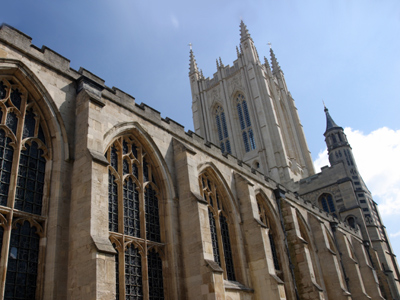
Ask the AI Tutor
Need help with Vikings in Britain? Ask our AI Tutor!
AI Tutor - Lucy
Connecting with Tutor...
Please wait while we establish connection

Edmund, King of East Anglia, was buried at the place now known as Bury St Edmunds. The photo shows the cathedral.
Vikings in Britain
Learn how Vikings travelled to Britain, raided monasteries, and built new settlements. This KS2 History quiz explores their journeys, battles, and the changes they brought.
1 .
What name was given to the part of England ruled by the Vikings?
Daneshire
Denmark
Danelaw
Daneland
The Danelaw included Yorkshire, the East Midlands and East Anglia, as well as Essex, Bedfordshire, Hertfordshire, Middlesex and Buckinghamshire
2 .
Which of these was NOT a Saxon Kingdom?
Northumbria
Mercia
Wessex
Yorkshire
Yorkshire was in the kingdom of Northumbria
3 .
In which year did the Vikings raid Lindisfarne?
293
593
793
993
They stole gold and valuables, murdered the monks and set the church on fire
4 .
Which Viking leader agreed the Treaty of Wedmore with King Alfred?
Guthrum
Raegnald
Guthlac
Odin
This treaty set out the borders between Wessex and the Viking lands
5 .
Which King of Wessex was 'Great'?
Edward
Edmund
Ethelred
Alfred
Alfred the Great held back the Viking invasion
6 .
Which Viking was crowned King of England in 1016?
Leif Ericsson
Canute
Sveyn Forkbeard
Guthrum
In all there were four Viking kings of England: Sveyn Forkbeard in 1013, Canute in 1016, Harold Harefoot in 1035 and Harthacnut in 1040
7 .
Which Saxon Kingdom was not ruled by the Vikings?
Mercia
Wessex
East Anglia
Northumbria
Wessex was the only Anglo-Saxon kingdom to withstand the Viking invasion
8 .
Who eventually regained control of England?
Edward the Elder
Edward the Confessor
Ethelred the Unready
Edmund Ironside
Edward was the son of Alfred the Great
9 .
Who was buried at the place now known as Bury St Edmunds?
Edmund, King of East Anglia
Edmund, King of England
Edmund, King of Wessex
Edmund, King of Kent
He was killed by the Vikings for refusing to give up Christianity - this made him a martyr and a saint
10 .
When did the Viking 'Great Army' arrive in England?
865
1065
1865
1965
This Viking army conquered the North East Anglo-Saxon kingdoms and founded a new Viking country called the Danelaw
**Unlimited Quizzes Await You! 🚀**
Hey there, quiz champ! 🌟 You've already tackled today's free questions.
Ready for more?
Ready for more?
🔓 Unlock UNLIMITED Quizzes and challenge yourself every day. But that's
not all...
not all...
🔥 As a Subscriber you can join our thrilling "Daily Streak" against other
quizzers. Try to win a coveted spot on our Hall of Fame Page.
quizzers. Try to win a coveted spot on our Hall of Fame Page.
Don't miss out! Join us now and keep the fun rolling. 🎉
**Unlimited Quizzes Await You! 🚀**
Hey there, quiz champ! 🌟 You've already tackled today's free questions. Ready for more?
🔓 Unlock UNLIMITED Quizzes and challenge yourself every day. But that's not all...
🔥 As a Subscriber you can join our thrilling "Daily Streak" against other quizzers. Try to win a coveted spot on our Hall of Fame Page.
Don't miss out! Join us now and keep the fun rolling. 🎉






